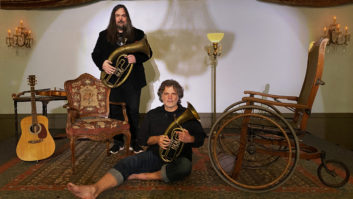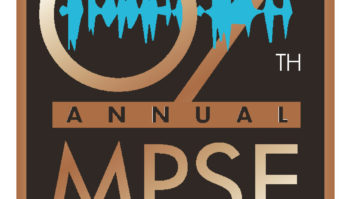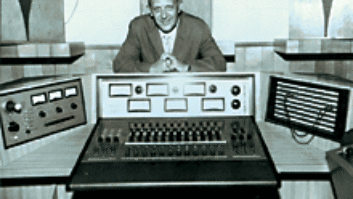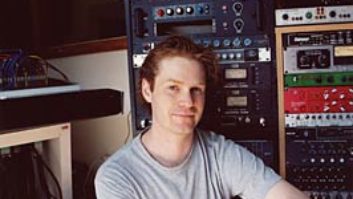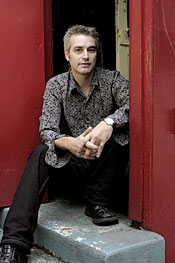
John Wesley Harding waited almost three years to release Adam’sApple, his 11th album overall and first for DRT Records. But theBritish singer-songwriter recorded the album in a matter of months,working with two different producers in two distinctly differentenvironments: a high-end commercial facility with the large-formatconsole and a Pro Tools — based home studio.
Rather than release the project himself after his then-label,Mammoth Records, shuttered and folded into Hollywood Records, Harding(aka Wesley Stace) delayed Adam’s Apple‘s release until he foundthe optimum label offer for what he considers his best work yet.“I don’t see many situations in which all the pieces fall intoplace so incredibly well, and with such good fortune, luck andlove,” says Harding from his New York home. “Theprofessionals that played on it, the people that worked on it…Ican’t see those things ever falling into place again, so I really feltthat it was worth waiting for.”
For Harding’s first commercial recording since The Confessions ofSt. Ace (2000), Mammoth president Rob Seidenberg recommendedco-producers Julian Raymond, Capitol Records’ senior VP of A&R, andEric Kupper, an in-demand keyboardist, remixer and producer in the popand dance scenes. “Basically, [Seidenberg] was less interested inme making folk music,” Harding admits. “He thinks my strongsuit is my pop songs, and this album was his idea to really present memaking pop music in the best possible way with the bestpeople.”
Raymond, whose production credits include Fastball, the CashBrothers and the Suicide Machines, brought ace musicians such asdrummer Vinnie Colaiuta, bassist John Pierce and guitarist Michael Wardto Henson Studios in Los Angeles to play on six of the album’s 12tracks. Working with engineer Greg Goldman, Raymond helped polishHarding’s hypnotic, acoustic-based melodies without burying his smart,witty lyrics.
“Julian really believes in paring a song down to its bareessentials,” Harding says. “It’s the first time I’ve everhad that kind of discipline for myself. If there’s not an absolutenecessity for a thing to be there, it’s not going to bethere.”
Harding, a skilled producer in his own right, admits that hisstrength lies in arrangements and melodies rather than technicalprowess. “We had no intro to the song ‘Nothing AtAll’ at first,” Harding admits. “And I thought,‘There’s got to be something,’ and I remember sayingto the bass player, ‘Why don’t you just go,“ba-da-da-da,” but more Motown, with these notes.’We’re all listening and Julian said to the bass player, ‘Wow,that’s a fantastic intro, John.’ And I was like,‘Great! I think so, too!’ Because I’m just humming newparts in my mind the whole time.”
Raymond may have given Harding’s intro a thumbs-up, but he didn’tapprove of a brief guitar line played by Kirk Swan, a member ofHarding’s touring band, the Radical Gentleman. “It was this verybig guitar riff and it’s very loud and unlike anything else on thetrack and I really wanted it to be there,” Harding says of thepart, which appears on “Nothing At All.” “Julianheard it and said, ‘Bang goes the radio. That’s the end of thatone! It will not be a single now.’ To him, it was one of thoseextraneous moments.”
In addition to keeping the songs uncluttered, Raymond also inspiredsome of Harding’s best vocal performances, even joining in on a few.“Julian is a fantastic harmony vocalist,” Harding says,adding, “but there is nothing better than me singing with Chrisvon Sneidern, who I’ve been singing with for years. He’s co-producedloads of albums with me and he’s the bass player of my touring band;I’m on his records and he’s on mine. Plus, he comes up with thepower-pop harmonies that I don’t quite have in my head. So to me, itwas just a no-brainer to get him to sing [on this album].”
For the six-song, six-day Henson sessions, Harding and crew set upin Studio B, home to an SSL 6056 E/G, Vincent Van Haaff/A&M mainmonitors and a wide assortment of vintage outboard gear. Overdubs tookplace in Studio C, which houses a 96-channel Euphonix CS3000. Goldmanused Pro Tools for editing, Logic for keyboard loops and Sony 3348 HRas the recording format. “As much as I love analog, we knew wewanted to be on digital eventually, and Chris Lord-Alge [who mixedseveral tracks at Image Recording Studios in Hollywood] likes to workoff of 3348,” Goldman explains. “Plus, digital’s so muchbetter for doing vocals.”
With the exception of Harding, who was isolated in one of Studio B’stwo booths, Goldman positioned the band in the 13×9-foot mainroom. He used a Neumann U47 FET on the bass drum, Shure SM57s for thesnare, Neumann KM84s on the hi-hat and ride, AKG C12s on the overheadsand Sennheiser 421s on toms. Miking guitars involved simply“sticking a 57 in front of the amp and running it through a Nevemodule and an 1176. Nothing fancy,” Goldman explains. “Ifyou have really great players, good instruments and good amps, you getgreat sounds.”
Working in one of L.A.’s finest facilities was admittedly arefreshing change for Harding, who tends to record “on thecheap.” “To me, it was great luxury, having somebody therewith printed-out copies of the lyrics, all the vocal takes inorder,” Harding says, complimenting Goldman’s organizationalskills. “And there was a very nice scene around the barbecuewhere I met Rupert Hine. It was a very good experience.”
Harding later enjoyed the luxury of time at Kupper’s Weston, Conn.— based home studio, Hysteria Recording, “where the onlywildlife is Keith Richards walking down the road every now andthen,” Harding jokingly says. “I would go up there for justtwo days at a time, every couple of weeks. [Kupper’s] work [ethic] ishe just goes. Once he started, I was not offered a cup of tea,water…you’re lucky to eat a sandwich at the beginning of theday!”
The focused Kupper works on a Pro Tools Mix|24 — equippedMacintosh G4 computer, sans control surface. Though he records andmixes inside the box, Kupper’s studio is “stuffed to thegills” with vintage equipment and instruments.
“My drum kit’s always miked up and the guitar amps are alwaysready to go,” Kupper says. “It’s set up for completecreativity. All the guitars — like 30-something guitars —are hanging on the walls like a guitar shop.”
The band, which at Hysteria included Fairport Convention drummerDave Mattacks, guitarist Gary Burnette (who produced Harding’s lastalbum) and Kupper, who contributed keyboards, bass and drumprogramming, nailed most tracks on the first take. “A lot ofpeople use Pro Tools to get absolute perfection, but for me, it’s aboutcapturing that raw performance, and it’s very often on the first take.You can clean something up later. Sometimes, it’s more natural to do itelectronically than have someone sit there and sing a part 20 timestill they just completely lose the vibe.
“For me, the challenge here was to capture that raw emotionand try to add technological elements to Wes’ music that he hasn’t usedbefore,” Kupper continues. “We both wanted to push theenvelope a little bit, and we did. I think we got some quirky,interesting tunes going on.”
For example, on “Monkey and His Cat,” Kupperincorporated loops with a ’60s drum sound. “It’s not lo-fi, butit’s not superglossy hi-fi either,” he says. “Sort of likeif you got an old hi-fi version of a Kinks record.”
Kupper also relied on such plug-ins as McDSP and DUI and choicepieces of vintage gear. For vocals, Kupper chose the Neumann CMV-563microphone running into a Tube-Tech MP1A preamp, through either a JoeMeek SC-2 compressor or Summit TLA-100A tube-leveling amplifier, andthen into Pro Tools. “If I needed a little EQ along the way, I’dput a vintage Calrec or Neve EQ in-line,” Kupper adds. To recordMattacks’ drums, Kupper used TL Audio and Millennia Media mic pre’s,and dbx 160X and UREI 1176 compressors to complement an assortment ofSennheiser, Audio-Technica, Shure and AKG microphones.
Kupper used a Shure SM57 to mike Burnette’s guitar amp. “Or ifI was feeling adventurous, I’d use what I call my ‘Beatleschannel,’ which is an old AKG D19 going into a Telefunken B72preamp into an Altec 438-C compressor.”
With both Hysteria and Henson sessions under wraps, Harding jettedto London to record “Sussex Ghost Story,” which featuresstring arrangements by modern classical composer Gavin Bryars.“It was a pretty left-field idea, but it was just the kind ofcenterpiece the album needed,” he says of the song, which wasrecorded at Electric Earth East by engineers Martin Terefe and GavinOlsson. Neil Perry mixed the track, along with a few Raymond-producedcuts, at Chung King in New York City. The album was later delivered toBernie Grundman Mastering, where Grundman and Brian Gardner added theirfinishing touches.
Despite the big studio/small studio dichotomy, Harding’s latest and,arguably, his strongest album to date flows seamlessly from acoustic toelectric, and from arty folk to melodic pop with consistent sonicintegrity. Kupper sums it up best, noting, “It ain’t about thegear; it’s about the ear.”
